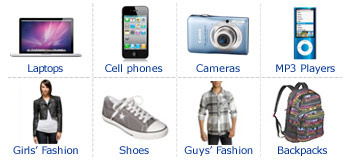Computer Terminology
|
|
Hard Disk Drive (HDD): This is the internal magnetic storage device housed inside
the computer case. These come in a variety of sizes, measured in how
many bits of information they can
contain. A bit of information equals either zero (0) or one (1).
To a computer, this is equivalent to turning a light switch off (0) or on
(1). Computers operate on bits in groups of 8, called a byte. Every byte contains 8 bits. Bits
and bytes can be stored magnetically on material that resembles cassette or
8-track recording tape. The magnetic material stores information as
sequences of the digits "0" and "1" (hence the name digital storage). Since it takes many bytes
to store such things as letters, words, and sentences, the amount of
information that a Hard Drive can store is measured in multiples of
1000-bytes, 1,000,000 bytes, or 1,000,000,000 bytes. Terms such as kilobyte (1000 bytes or 1KB),
megabyte (1,000,000 bytes or 1MB), and gigabyte
(1,000,000,000 bytes or 1GB) have evolved to
represent these storage capacities. When you purchase a computer, get
as large a Hard Drive as you can afford. The standard in 1998 was
between 4GB and 8GB. The Hard Disk Drive is often referred to as the "C:" drive.
|
Floppy Diskette: The floppy diskette is a removable storage device that is
used by the
| |
Keyboard: The main tool to get information into the computer and the
most common way to tell the computer what you want it to do. Most
keyboards have the same arrangement of keys as a typical typewriter
keyboard. Computer keyboards have additional keys that perform
computer-specific functions.
| |
Modem: A telecommunications peripheral device that allows
computer to communicate with one another via conventional telephone
lines. Modems are required for home computers to access the
Internet or to send and receive facsimile transmissions (FAX). Modems are rated by their
speed in moving data from the computer to the telephone line. This
speed is measured in bits per second (bps). Standard modern modems are
rated at 28,800 bps, 33,600 bps and 56,400 bps.
| |
Motherboard: The circuit board on which most of the major electronic
components are situated. Most manufacturers integrate cable attachment ports on the back-end of the motherboard.
They also include slots so that owners can
add their own cable attachment ports. The slots are designed to accept cards. These are normally found near the back
of the computer case.
| |
MS-DOS: An older operating system that powered personal computers
through their beginning years. Prior to the development of the
graphics-oriented Macintosh and Windows operating systems, this system relied
on typing commands one line at a time to tell the computer what you wanted it
to do. This system is still in use in the Windows family of software
and still has many practical uses. Windows 3.1 relies on MS-DOS to
operate. MS-DOS stands for Microsoft-Disk
Operating System.
| |
Network Card: A card that can be installed in one of the motherboard
slots to give the computer the ability to talk to other computers with
similar cards. A collection of similarly equipped computers connected
by specially designed cables is known as a network.
The mechanism (including languages and protocols) used to communicate on a
network are varied, but the most common networking designs in use are Ethernet and Token Ring.
| |
Operating System
Software (OS): The instructions that allow the
computer to start working and permit it to run other programs. The
major OS software types include MS-DOS, Windows 3.1, Windows 95, Windows NT,
Macintosh, UNIX, and LINUX. The most popular OS in use at present
is Windows 95. Most computers come with one of these pre-installed.
|
RAM: This acronym stands for Random
Access Memory. RAM is commonly called "memory".
Memory is measured in megabytes (MB) and usually comes in multiples of
2 or 4. The more RAM that a computer has, the better it can carry out
instructions. It is recommended that a new computer have
|
WANT MORE NOTES AND FORMATION?
CONTACT US
+2347030722911
NAIJA SOFTWARE CHEATS















0 comments:
Post a Comment
Sign-in to comment
Note: Only a member of this blog may post a comment.